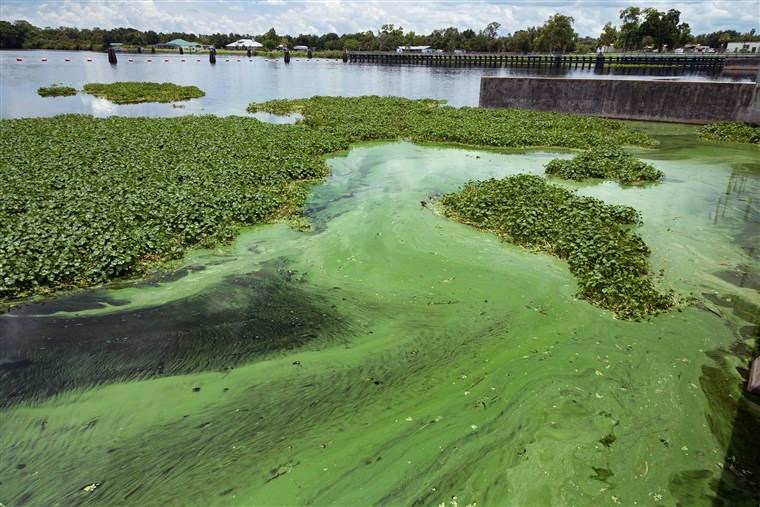Last year, the toxic algae fouling Southwest Florida’s inland waterways and coastline made it difficult for people to not only enjoy our amazing state but for health officials to answer questions they themselves didn’t always feel able to answer (or want to, for that matter). Residents and visitors alike wanted to know if Caloosahatchee blue crabs were safe to eat or if it was “dangerous to breathe near the algae-choked canals,” even if they should be swimming in the Gulf.
However, regardless of the question, including important ones like who was posting warning signs, or what agency was monitoring illness reports, the Florida Department of Health stayed largely in the background. And silent.
And so, after refusing The News-Press’ interview requests, using public records requests, The News-Press obtained more than 2,500 emails from May 25 to Sept. 26 that revealed “a hunkered-down agency scrambling to keep its message straight as the environmental calamity deepened.”1
The team requested records from the two officials whose names appeared in the infrequent news releases the department issued about the situation, Kendra Goff, state toxicologist and chief of the Bureau of Environmental Health and Andy Reich, scientific adviser for the bureau.1 The 2,661 emails were reviewed by the department’s legal team and sensitive information was redacted. However, what remains (which The News-Press still is analyzing) shows a wide range of concerns that- more often than not- left people with more questions than answers.
What follows below is the hard (and ongoing) work of the staff at The News-Press. The email exchanges are included to show how little the department was doing. Thank you again to The News-Press:
In August the Department of Environmental Protection’s John Calhoun asked about hot spot air testing: ”We are getting lots of calls from citizens requesting air testing around ponds with algae blooms. We usually refer to the County, who refer them to the local Health Dept, who refer them back to us and our Division of Air. Unfortunately, our Division of Air only does static monitoring of specific locations and doesn’t have the equipment to do local testing like that. Does DOH have any ability & capacity to do such localized air testing?”
Goff answered: “Unfortunately, we do not have any capabilities to perform air testing, localized or not. For more information on harmful algal blooms, people can be directed to our website. In general, we advise folks to take precautions around water bodies that may have harmful algal blooms. Happy to chat further.”
Concerned for the health of his two young daughters, Quillen pressed Angela Smith, who administers Lee’s health department, to tell him whether Sanibel Island was safe for his girls. She responded with generalities and gave him some informational links. They went back and forth a couple of times until Quillen had enough.
“Thank you for your response but you did not answer my question. Is it safe for my family to live in these conditions with these algae blooms and this red tide?” he wrote. “Why can’t I get a straight answer?”
After that, Smith didn’t write back.
Dagmar and Steve Martin, who live on a dead-end Cape Coral canal contacted the department in July about the algae’s foul smell.
“We are permanent residents and have no other place to stay,” the Martins wrote. “We don’t know how toxic the algae is. … We are hoping to get help as soon as possible!”
The email wound up in Reich’s queue, but he did not write the Martins back.
Aug. 22, 2018, Pam Cox sent the department what she called a plea “to acknowledge the conditions with the Red Tide/Blue Green Algae crisis. Your website and silence on the current health situation is gross negligence … PLEASE, PLEASE, PLEASE … whoever is monitoring this mailbox, bring it forward to others in your office. Don’t just send an automated reply and delete it.”
Reich wrote back: “Dear Ms. Cox Thank you for your email to Florida Department of Health. The Department’s role in responding to red tide events relates to health concerns. You can find information on health effects of algal blooms on our website. Sincerely, Andrew Reich”
On Aug. 17, JoEllyn Bavosa wrote, asking, “When will you help? When will you start testing? When will you issue warnings to the public about Cyanobacteria? This is not just Red Tide anymore and has not been for a very long time. With hope that your agency will step forward and help.”
Reich didn’t write Bavosa back, but he did send a colleague this: “There really is nothing we can say to address this email. Andy.”
Other correspondence included:
- Reich’s response about whether freshly hunted alligator meat from an area of bloom is safe to eat: “It’s my best guess that the toxins would not accumulate in the muscle tissue but without data, there is no way of knowing for sure.”
- Goff telling epidemiology department chief, physician Russell Eggert, July 12, “We would like to discuss how we are going to handle these inquiries and we will need some help. We are not used to this volume of inquiries.”
- Martin County environmentalist and former Commissioner Maggy Hurchalla writing: “This is Florida’s Flint, Michigan — ignoring a problem because it is too scary and difficult to deal with.”
- And in one of Goff’s email threads, Martin County Commissioner Ed Fielding wrote presciently: “It portends to be a long, disastrous summer.”
Health coach Ralph Quillen from Sanibel Island, hemmed in by red tide in late August, as toxic cyanobacteria flowed down the Caloosahatchee wrote city government – “I need to know if it is safe for my family, specifically my 3 and 6-year-old girls to live in these conditions?”
Angela Smith, who administers Lee’s health department, wrote back: “We are not aware of any long term negative effects of red tide. For most people, symptoms are temporary and resolve when the person leaves the proximity of the impacted water. Unfortunately, I cannot comment on your family specifically due to the fact that K. brevis impacts individuals so differently. Some individuals experience “red tide tickle” while others do not. Still other individuals with existing pulmonary issues may experience more severe reactions. I would encourage you to speak with your healthcare provider if you have specific questions regarding your family’s health.”
Quillen replied: “Hello Angela, Thank you for your response but you did not answer my question. Is it safe for my family to live in these conditions with these algae blooms and this red tide? We have over 100 children on Sanibel and the island is surrounded with this poison. Should the school be handing out filter masks? What are the long term effects? Will this affect our children’s health in the future. Why can’t I get a straight answer?”
Smith wrote back to tell him, among other things, that “For sensitive individuals, wearing a particle filter mask may lessen the effects, and over-the-counter antihistamines decrease symptoms.” She also referred him to the Florida’s Fish and Wildlife Conservation Commission and to Mote Marine’s online beach report.
By now, Quillen said, he was getting frustrated. “Hi Angela, Thanks for your response but I think I am going to have ask this question again. It is a yes or no question. Is my family safe to live on this island? Is the air safe? Also, has Lee county been running air quality tests? Are the tests available to review? Have you been out to the island to see the devastation? … I look forward to your response.”
But after that, Smith never responded, even though she blind-copied Quillen’s emails up the chain of command until they reached Reich.
Quillen’s conclusion?. “The emails speak for themselves. They basically did nothing. And we’re still left with no answers.”
The News-Press repeatedly queried the department as well, even finding an email this reporter had sent to a university professor (who doesn’t work at the department) about the department’s ongoing silence in Reich’s queue: “I’ve had a devil of a time communicating with the Florida Department of Health. Among other things, I’ve been asking about whether local fish catches are being monitored or tested, as well as non-fin fish seafood, especially blue crabs. Most importantly, though, I wanted them to tell me if there’s any kind of epidemiologic surveillance plan in place – or being discussed – for short- and long-term human health impacts, whether it’s something the DOH would do, or if not what agency would.”
His receipt of the email notwithstanding, Reich never responded to her.
Other citizens who wrote got shorter responses – if they got any. Here are some excerpts:
July 11, Dagmar and Steve Martin of Cape Coral wrote:
“We live at the end of a canal … The algae’s smell really bad. We can’t sit outside or even work in the backyard … The smell is already in the house. We are concerned about our health. It’s impossible to live like that! There are small children living in the neighborhood as well. We are permanent residents and have no other place to stay. We don’t know how toxic the algae is. We experience a dry and scratchy throat and believe it has to do with the bad smell. We don’t know if there are injured or dead fish or other wild life. We are hoping to get help as soon as possible!”
No return email was included in the public records The News-Press received.
Aug. 17, JoEllyn Bavosa wrote:
“As a resident of Florida for over 20 years it is a huge concern of mine to find that our waters have not and are not being tested for Cyanobacteria. As we are NOW in a state of emergency and our canals, bays and gulf are filled with “green slime” and our marine life is dead or dying, I was wondering when exactly we would start testing for Cyanobacteria and the toxin it releases? I have asked our local Sarasota Board of Health and the response was and still is, we only test what we are told to test. Another concern is that the County and State Officials make it perfectly clear that our beaches are open, and have never closed, and “sure you can go out there, however I would not.” (City of Sarasota 6/16/18 video) When questions are asked of our “Officials,” they refer us to Mote marine, who does not even staff a Cyanobacteria specialist or to your Department. Cyanobacteria, as I am sure you are aware, risks the very health, lives and water we drink, of the people exposed to it for prolonged periods of time. When will you help? When will you start testing? When will you issue warnings to the public about Cyanobacteria? This is not just Red Tide anymore and has not been for a very long time. With hope that your agency will step forward and help.”
No return email was included in the public records The News-Press received, but Reich did send a colleague this: “There really is nothing we can say to address this email. Andy.”
Aug. 22, Pam Cox wrote:
“This email is a plea to the team at the FL Department of Health to acknowledge the conditions with the Red Tide/Blue Green Algae crisis. Your website and silence on the current health situation is gross negligence on the mission of your department ““to protect, promote and improve the health of all people in Florida through integrated state, county, and community efforts”. I have to believe that people who work at the FDOH are members of the communities who are impacted by this man-made ecological disaster. There are many scientists who have researched and provided evidence of the health risks. The citizens of Florida are getting sick and are outraged that the state is not doing anything. I realize this is not an easy situation and politics are playing a huge role in determining what employees of the state are willing to say. However, this issue is attacking the health of people in Florida and the FDOH needs to get involved. PLEASE, PLEASE, PLEASE …. whoever is monitoring this mailbox, bring it forward to others in your office. Don’t just send an automated reply and delete it. Read my words, feel the tears and despair that I and my fellow Floridians are feeling. Help us by acknowledging the issues and standing with us to request attention and funding from the state.”
Reich wrote back: “Dear Ms. Cox Thank you for your email to Florida Department of Health. The Department’s role in responding to red tide events relates to health concerns. You can find information on health effects of algal blooms on our website: http://www.floridahealth.gov/environmental-health/aquatic-toxins/index.html Sincerely, Andrew Reich”.
Summer is coming and so is the potential for more outbreaks. However, the health department has not only rolled out an informational web page on cyanobacteria but it’s also now taking responsibility for posting warning signs. So, we have hope.
And after last season, we need it.
SOURCE:












